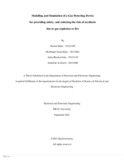| dc.contributor.advisor | Bhuian, Mohammed Belal Hossain | |
| dc.contributor.author | Khan, Rafsan | |
| dc.contributor.author | Khan, Mashfiqul Islam | |
| dc.contributor.author | Soha, Anika Bushra | |
| dc.contributor.author | Zayed, Abdullah Al | |
| dc.date.accessioned | 2022-03-14T05:54:20Z | |
| dc.date.available | 2022-03-14T05:54:20Z | |
| dc.date.copyright | 2021 | |
| dc.date.issued | 2021-09 | |
| dc.identifier.other | ID 18121109 | |
| dc.identifier.other | ID 18121062 | |
| dc.identifier.other | ID 19121139 | |
| dc.identifier.other | ID 18121060 | |
| dc.identifier.uri | http://hdl.handle.net/10361/16451 | |
| dc.description | This thesis is submitted in partial fulfillment of the requirements for the degree of Bachelor of Science in Electrical and Electronic Engineering, 2021. | en_US |
| dc.description | Cataloged from PDF version of thesis. | |
| dc.description | Includes bibliographical references (pages 73-76). | |
| dc.description.abstract | The Internet of things (IoT) has been a current topic of interest. It creates an interconnection between electronic devices, computers, and human beings. Implementing IoT can be highly beneficial for humanity for various reasons, such as safety. The accidents which occur due to flammable gas explosions and leakage have been an ongoing problem in Bangladesh. While many settlements possess safety anti-fire alarms, it is noteworthy that such facilities are not accessible by the majority of the people in our country. Thus, we developed a gas detecting device that acts according to how it is programmed to systematically let the user know of an abrupt change in gas concentration in the surroundings where the device operates and, hence, work accordingly to lower the risks of any adverse development as explosions or fire. Ideally, the device is placed around stoves, machines, or any place where flammable gas exposure is present. The whole architecture has four parts – 1) Simulation, 2) Mechanical, 3) Electrical, and 4) Software. In this thesis, to prove our whole concept, we will simulate the software, hardware, and electrical parts in depth. | en_US |
| dc.description.statementofresponsibility | Rafsan Khan | |
| dc.description.statementofresponsibility | Mashfiqul Islam Khan | |
| dc.description.statementofresponsibility | Anika Bushra Soha | |
| dc.description.statementofresponsibility | Abdullah Al Zayed | |
| dc.format.extent | 76 pages | |
| dc.language.iso | en | en_US |
| dc.publisher | Brac University | en_US |
| dc.rights | Brac University theses are protected by copyright. They may be viewed from this source for any purpose, but reproduction or distribution in any format is prohibited without written permission. | |
| dc.subject | IoT | en_US |
| dc.subject | Gas detecting device | en_US |
| dc.subject | Simulation and modelling | en_US |
| dc.subject | Gas explosion | en_US |
| dc.subject.lcsh | Internet of things. | |
| dc.title | Modeling and simulation of a gas detecting device for providing safety; and reducing the risk of accidents due to gas explosion or fire | en_US |
| dc.type | Thesis | en_US |
| dc.contributor.department | Department of Electrical and Electronic Engineering, Brac University | |
| dc.description.degree | B. Electrical and Electronic Engineering | |

